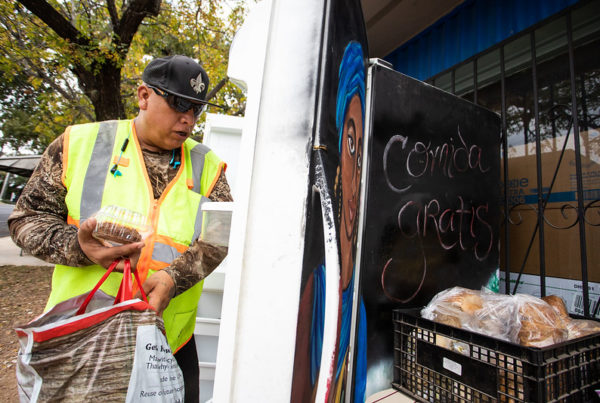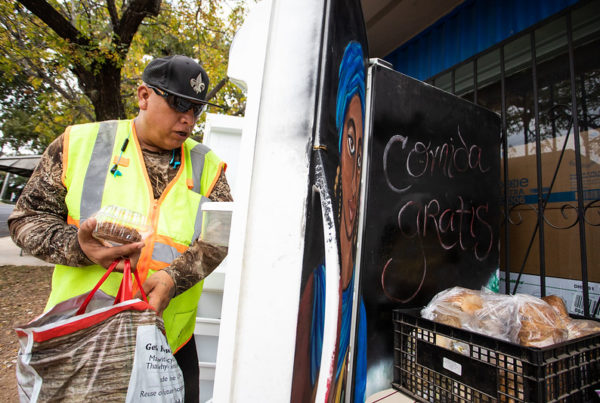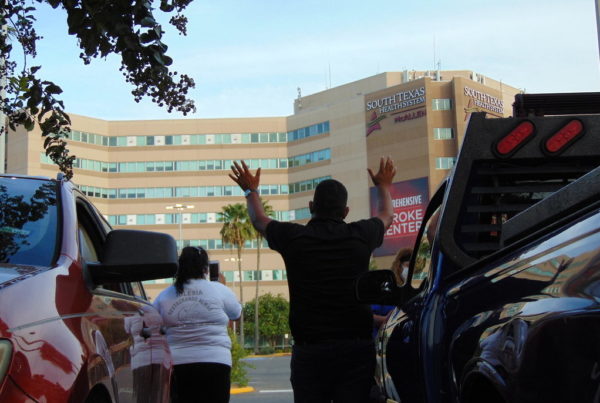Earlier this month, a small group of local artists and monarch butterfly enthusiasts put together an ofrenda in San Antonio’s Confluence Park, near the point where San Pedro Creek connects with the San Antonio River.
The altar featured many of the traditional Dia de los Muertos offerings: pan de muerto – the traditional sweetbread, orange and yellow marigolds, sugar skull figures, a shot of tequila and small statutes of butterflies. All are symbols associated with the annual Mexican day of remembrance – which falls on Nov. 1. – for departed friends and relatives.

San Antonio artist Jose Sotélo creates a community ofrenda, a traditional altar displayed during Día de Muertos, for the Monarch Butterfly and Pollinator Festival at Confluence Park. The 2020 festival will be held online. Michael Minasi/Texas Standard
The group was organized by Monika Maeckle, founder and director of the Monarch Butterfly and Pollinator Festival in San Antonio. Because of the coronavirus pandemic, this year’s festival, which celebrates the annual migration of the butterflies’ migration from northeast of the Rocky Mountains to Mexico, was refashioned into a memorial for those who have died of COVID-19.
Each year, the monarchs make their way to Central Texas around Dia de Los Muertos.
“We’re in a very unique spot geographically,” Maeckle said. “A very strategic spot where all these different cultures come together, all these different ecosystems come together, all these different creatures come together.”
But this year’s celebration will be particularly difficult in San Antonio, where 65% of COVID-19 deaths have been among the city’s Hispanic residents.
Maeckle’s organization wanted to combine their love of monarch butterflies and their annual migration with helping residents remember those they’ve lost this year to the coronavirus.

A Monarch butterfly tagged with the name of an individual lost to COVID-19, clings to a marigold at the community ofrenda during the Monarch Butterfly and Pollinator Festival at Confluence Park. The 2020 festival will be held online.
Michael Minasi/Texas Standard
“These are not just numbers,” Maeckle said.
Near the ofrenda, Maeckle’s group brought butterflies, tagged with stickers in honor of someone who had died of COVID-19.
“These are people with families who are mourning and grieving and it’s very difficult to do that right now where you can’t even hug each other,” she said.
Those loved-ones’ names will be added to the databases of individual monarchs that are tagged. Adriana Rocha Garcia represents San Antonio City Council District 4.
“The district I represent is an under-insured community,” Rocha said. “We have folks that work two or three jobs to make ends meet and a majority of my district is Hispanic. A lot of the folks in my district are over the age of 55.”
More than 13% of COVID-19 deaths in San Antonio have been people living in Rocha Garcia’s district. But not only has the novel coronavirus affected her constituents, it’s also hit her own family hard. She’s lost six cousins and an uncle to COVID-19. So she requested several monarchs be tagged in their memories.

San Antonio artist Jose Sotélo sets up an ofrenda, a traditional altar displayed during Día de Muertos, for the Monarch Butterfly and Pollinator Festival at Confluence Park. The 2020 festival will be held online.
Michael Minasi/Texas Standard
“Ever since I was young I was taught that butterflies, monarch butterflies specifically, were that reminder that our loved ones would come back to visit us,” Rocha recalled.
The monarchs’ symbolism can be traced back to indigenous tribes of Mesoamerica. They associated the monarch, and butterflies in general, with the life cycle and the after-life.
“They go into this period of transformation in which they are in a cocoon and we can liken that to death,” said Aimee Villarreal, director for the Center of Mexican-American Studies and Research at Our Lady of the Lake University in San Antonio. “And then are reborn in such a radical way that is extremely different from where they started.”

Monika Maeckle, founder of the Monarch Butterfly and Pollinator Festival, releases a Monarch butterfly tagged with the name of an individual lost to COVID-19.
Michael Minasi/Texas Standard
On that Sunday earlier this month at Confluence Park, Maeckle and her team of butterfly researchers tagged around 200 monarch butterflies nearby. Ten butterflies at a time were released near the ofrenda.
Some of the monarchs stuck around for a little while. They landed on its pollinator plants and marigolds, near the dozens of photos of loved ones adorning the altar. Ceiva Ili, a local teacher and musician, brought a hand-carved, wooden flute to play a song for the butterflies as they were released.
“As the butterflies take flight and go on their journey, it will almost be like a blessing from them to me and from me to them on their journey,” said Ili.
Other monarchs that were released seemed eager to continue their journey, immediately flying towards the San Antonio River. If all goes well, these butterflies will be arriving in southern Mexico soon, just in time for Dia de los Muertos.














